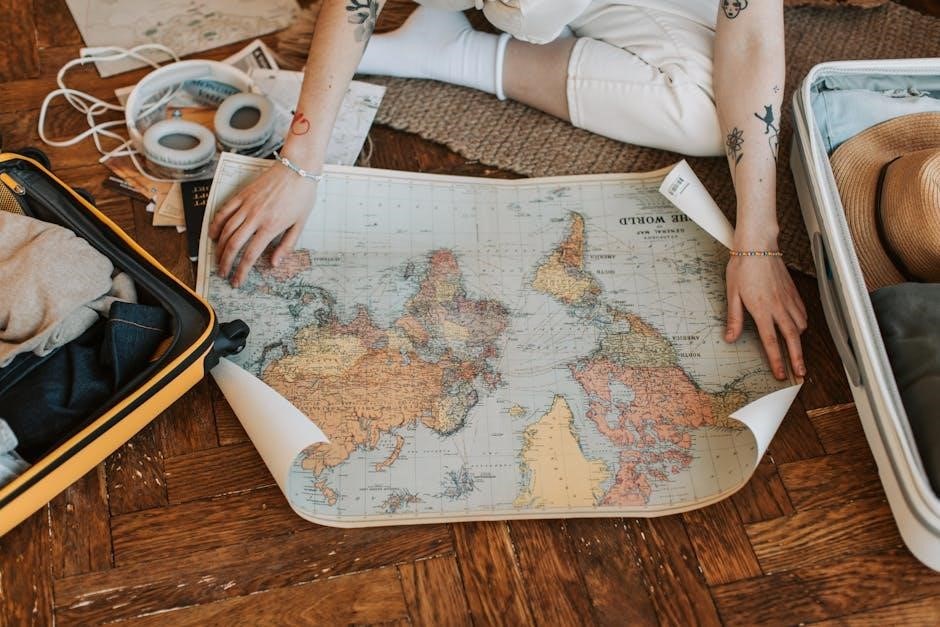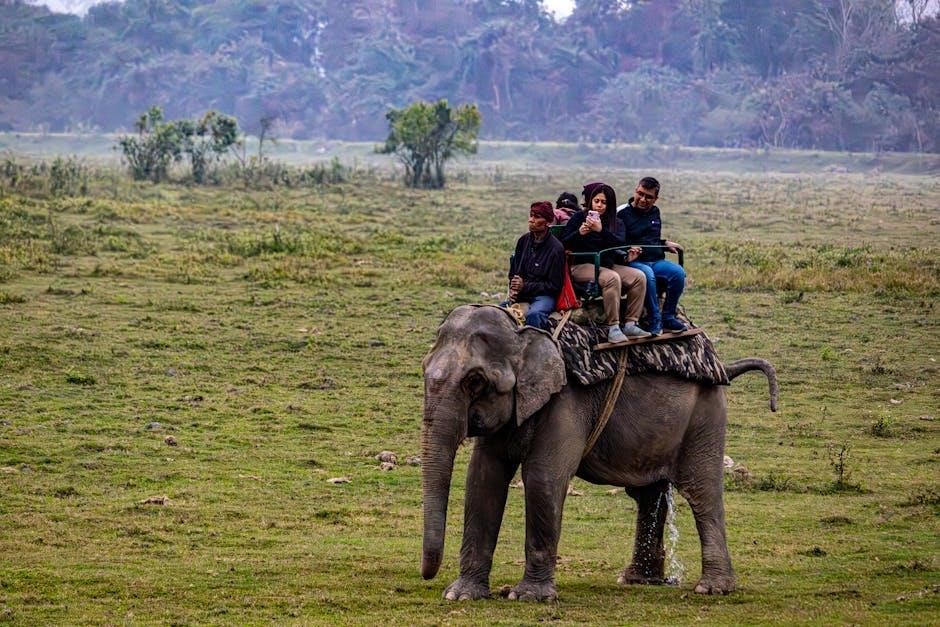
-
By:
- otis
- No comment
self guided trips
Self-guided trips offer travelers the freedom to explore destinations at their own pace, combining independence with expertly curated resources like maps and detailed notes for a seamless adventure.
What is a Self-Guided Trip?
A self-guided trip is a travel experience where you plan and navigate your journey independently, without a traditional tour guide. You have the freedom to create your own itinerary, choosing destinations, activities, and pacing that suit your preferences. This type of travel often involves pre-booked accommodations and transportation, but you explore on your own, making decisions as you go. It’s ideal for those who enjoy autonomy, flexibility, and the opportunity to immerse themselves in local cultures at their own pace.
Advantages of Self-Guided Travel
Self-guided travel offers unparalleled flexibility, allowing you to tailor your journey to personal preferences. Without a fixed schedule, you can explore at your own pace, spending more time on what interests you most. It often proves cost-effective, as you avoid the expenses of guided tours. Additionally, self-guided trips foster deeper cultural immersion, enabling authentic interactions with locals and a more meaningful connection to the places you visit. This independence empowers travelers to create memorable experiences that align with their unique interests and goals.
How Self-Guided Tours Differ from Guided Tours
Self-guided tours offer independence and flexibility, allowing travelers to explore without a structured group or leader. Unlike guided tours, which follow a set itinerary and timeline, self-guided trips enable you to create your own schedule and pace. While guided tours provide expert insights and convenience, self-guided options often cost less and allow for a more personalized experience. This approach suits adventurous travelers who prefer autonomy and the freedom to make spontaneous decisions during their journey.

Planning a Self-Guided Trip
Proper planning is key to a successful self-guided trip, involving research, itinerary creation, and budgeting. Stay organized, flexible, and prepared for a seamless adventure.
Choosing Your Destination
Choosing the right destination for your self-guided trip involves assessing your interests, budget, and travel style. Consider popular spots with easy navigation, such as cities with well-connected public transport or regions with scenic routes for cycling or driving. Weather and seasonal factors are crucial—opt for destinations with favorable conditions during your travel dates. Safety and accessibility should also be priorities, especially if you’re traveling solo. Research destinations thoroughly to align with your preferences and ensure a smooth, enjoyable experience. Proper planning helps create lasting memories.
Creating a Detailed Itinerary
Creating a detailed itinerary is essential for a seamless self-guided trip. Start by breaking down your trip day by day, including accommodations, transportation, and key activities. Allocate specific time slots for sightseeing, meals, and relaxation to ensure a balanced pace. Research opening hours, ticket requirements, and travel distances to avoid delays. Prioritize must-see attractions while allowing flexibility for spontaneous discoveries. Use digital tools or travel apps to organize your plans and share them with companions. A well-structured itinerary enhances your travel experience and reduces stress, ensuring you make the most of your adventure.
Researching Local Attractions and Activities
Researching local attractions and activities is crucial for maximizing your self-guided trip experience. Start by identifying must-see landmarks, cultural sites, and hidden gems using travel guides, blogs, and tourism websites. Check attraction websites for ticket requirements, opening hours, and entry fees. Look for local events or festivals during your visit to enrich your trip. Organize your findings into categories, such as historical sites, dining, or outdoor adventures, to create a balanced and engaging experience. Use apps or maps to visualize locations and plan efficient routes, ensuring you don’t miss out on unforgettable experiences.
Budgeting and Cost Management
Budgeting and cost management are essential for a stress-free self-guided trip. Start by setting a realistic budget based on your destination and travel style. Prioritize expenses, allocating funds to accommodations, transportation, food, and activities. Book accommodations and transportation in advance to secure better rates. Track daily spending using budgeting apps or spreadsheets to stay on course. Consider free or low-cost activities to save money without compromising experiences. Regularly review and adjust your budget to ensure you stay within limits and enjoy your trip without financial strain.

Popular Destinations for Self-Guided Adventures

Europe offers iconic cities and landscapes, while New Zealand is a paradise for outdoor enthusiasts. North America provides diverse scenery and cultural experiences, perfect for self-guided exploration.
Europe: Iconic Cities and Landscapes
Europe is a treasure trove of iconic cities and breathtaking landscapes, making it a top choice for self-guided travelers. From the romantic canals of Venice to the historic streets of Paris, every city tells a unique story. The Swiss Alps, Norwegian fjords, and Mediterranean coastlines offer stunning natural beauty. With well-connected transportation networks and vibrant cultures, Europe allows travelers to explore freely. Whether strolling through Barcelona’s Gothic Quarter or hiking in Croatia’s Plitvice Lakes, the diversity of experiences ensures an unforgettable adventure.
New Zealand: Outdoor Paradise
New Zealand is a haven for outdoor enthusiasts, offering breathtaking landscapes and diverse activities. From the stunning fjords of Milford Sound to the rugged beauty of Mount Cook, the country is a paradise for self-guided explorers. With its well-marked trails, scenic drives, and adventure sports like hiking, kayaking, and bungee jumping, New Zealand caters to all kinds of travelers. The flexibility of self-guided trips allows visitors to immerse themselves in the pristine wilderness, vibrant culture, and serene natural wonders at their own pace, creating unforgettable memories.
North America: Diverse Scenery and Culture
North America offers a rich tapestry of landscapes and cultural experiences, making it ideal for self-guided trips. From the iconic cities of the United States to the vast wilderness of Canada, and the vibrant culture of Mexico, travelers can explore diverse environments at their own pace. The Grand Canyon, Yellowstone, and Niagara Falls are just a few natural wonders, while cities like New Orleans, San Francisco, and New York provide a blend of history, art, and cuisine. Self-guided adventures allow travelers to immerse themselves in the continent’s endless variety of scenery and culture.
Types of Self-Guided Trips
Self-guided trips offer diverse experiences, including walking tours, cycling holidays, and self-drive adventures, allowing travelers to explore at their own pace and preference.

Self-Guided Walking Tours
Self-guided walking tours are a popular choice for travelers seeking immersive experiences at their own pace. These tours allow individuals to explore cities, historical sites, or natural landscapes without a group or guide. With pre-planned routes and itineraries, walkers can discover hidden gems, enjoy scenic views, and engage deeply with local cultures. Many destinations, like Europe’s cobblestone streets or New Zealand’s trails, offer well-marked paths and accessible infrastructure. This style of travel fosters independence, flexibility, and a sense of accomplishment, making it ideal for those who cherish solitude or prefer a personalized journey.

Self-Guided Cycling Holidays
Self-guided cycling holidays offer a unique way to explore destinations at your own pace. These trips typically include pre-planned routes, bike rentals, and luggage transfers, allowing you to focus on the ride. Cyclists can immerse themselves in diverse landscapes, from rolling countryside to coastal paths. With detailed maps and GPS guides, navigation is straightforward. This style of travel combines physical activity with cultural exploration, offering a sense of freedom and accomplishment. It’s ideal for those who enjoy adventure, nature, and the flexibility to create their own memorable experiences on two wheels.
Self-Drive Tours and Road Trips
Self-drive tours and road trips provide unparalleled freedom to explore destinations at your own pace. With a rented vehicle, you can craft your own route, stopping at hidden gems and scenic spots. These trips often include pre-booked accommodations and tailored itineraries, allowing you to focus on the journey. The flexibility to drive wherever you please makes this style ideal for adventurers seeking immersive experiences. Enjoy breathtaking landscapes, local cuisine, and cultural encounters while embracing the thrill of the open road. It’s a perfect blend of adventure and personalization.

Benefits of Self-Guided Travel
Self-guided travel offers flexibility, cost-effectiveness, and immersive cultural experiences, allowing travelers to tailor journeys to personal preferences and explore destinations at their own pace.
Flexibility and Personalization
Self-guided trips offer unparalleled flexibility, allowing travelers to craft journeys tailored to their interests and pace. Without rigid schedules, you can explore at leisure, adjusting plans spontaneously. This personalization enables deeper connections with destinations, as you focus on what truly matters to you. Whether deviating from plans to discover hidden gems or lingering at favorite spots, self-guided travel empowers you to create meaningful, unforgettable experiences.
Cost-Effectiveness
Self-guided trips are often more budget-friendly than traditional guided tours, as they eliminate the cost of hiring a guide or joining a group. Travelers can allocate resources based on personal preferences, opting for affordable accommodations or dining options. Without fixed tour prices, you save money while enjoying the freedom to spend where it matters most. This financial flexibility makes self-guided travel an attractive choice for those seeking value without compromising on experience.
Immersive Cultural Experiences
Self-guided trips allow travelers to deeply connect with local cultures by exploring at their own pace. Without rigid schedules, you can engage authentically with locals, savor regional cuisine, and discover hidden gems. By immersing yourself in daily life, you gain a richer understanding of traditions, customs, and lifestyles. This personalized approach fosters meaningful interactions, creating lasting memories and a deeper appreciation for the destination’s cultural heritage. Self-guided travel encourages a more intimate and enriching connection with the places you visit.

Tips for a Successful Self-Guided Trip
Plan meticulously, research thoroughly, and stay flexible. Utilize maps, apps, and local guides for navigation. Pack essentials, and prepare for unexpected challenges. Enjoy the journey!
Essential Research and Preparation
Thorough research is vital for a smooth self-guided trip. Start by understanding your destination’s culture, language, and local customs. Plan your itinerary, including transportation and accommodation, and book in advance for popular spots. Research local laws, safety tips, and weather conditions. Gather essential documents like maps, guidebooks, and travel insurance details. Familiarize yourself with navigation tools and apps to stay on track. Lastly, prepare a contingency plan for unexpected situations, ensuring flexibility and peace of mind during your adventure.
- Study maps and guides to avoid getting lost.
- Learn basic phrases in the local language.
- Check visa and health requirements.
Using Technology for Navigation
Technology is a key tool for navigating self-guided trips. GPS apps like Google Maps and Maps.me provide real-time directions and offline functionality, ensuring you stay on course. Many apps also offer features like location sharing and points of interest. Translation apps can help communicate in foreign languages. Additionally, platforms like Rome2rio and Komoot offer tailored route planning for walking, cycling, or driving. Always download maps beforehand for areas with limited internet access to avoid getting lost.
- Download offline maps for remote areas.
- Use translation apps for local communication.
- Plan routes with specialized apps like Komoot.
Packing and Logistics
Packing and logistics are crucial for a smooth self-guided trip. Select versatile, lightweight clothing suitable for various activities and weather conditions. Essentials like a first-aid kit, travel documents, and a reliable backpack are must-haves. Plan transportation and accommodations in advance to ensure seamless transitions. Consider renting equipment locally to save space. Check the weather forecast to pack appropriately. Additionally, use packing cubes to organize your belongings efficiently, and consider reusable items like water bottles to reduce waste. Leave extra space in your luggage for souvenirs and items purchased during your journey.
- Select versatile, lightweight clothing.
- Pack essentials like a first-aid kit and travel documents.
- Plan transportation and accommodations in advance.
- Consider renting equipment locally.
- Check the weather forecast before packing.
- Use packing cubes for organization.
- Bring reusable items like a water bottle.

Testimonials and Success Stories
Travelers rave about self-guided trips, describing them as empowering and liberating. Many share stories of personal growth, unforgettable memories, and deeper connections with destinations. These testimonials inspire others to embrace self-guided adventures, highlighting the joy of exploring at one’s own pace;
Real-Life Experiences from Travelers
Many travelers share inspiring stories of their self-guided adventures, highlighting the freedom and joy of exploring at their own pace. A couple from the U.S. described their self-guided trip through Europe as “life-changing,” allowing them to discover hidden gems. A solo traveler in New Zealand emphasized the confidence gained from navigating independently. Families often praise the flexibility, as it lets them tailor activities to everyone’s interests. These real-life experiences showcase how self-guided trips foster deeper connections with cultures and landscapes, creating lasting memories.
Common Mistakes to Avoid
Overplanning and rigid itineraries can stifle spontaneity, while under-researching destinations may lead to missed opportunities. Many travelers forget to check local regulations or weather conditions, causing avoidable disruptions. Others overpack, adding unnecessary stress. Neglecting to budget for unexpected expenses is another common error. Additionally, relying solely on digital maps without backups can lead to navigation issues. Lastly, some travelers overlook the importance of rest days, risking burnout. Avoiding these mistakes ensures a smoother, more enjoyable self-guided experience.

How to Choose the Right Self-Guided Tour Operator
Research operators with excellent reputations, read reviews, and ensure they offer tailored services. Look for clear communication, flexibility, and customization options to suit your preferences and needs.
Reputation and Reviews
When selecting a self-guided tour operator, prioritize those with a strong reputation and positive reviews. Check third-party platforms, forums, and testimonials to gauge reliability and customer satisfaction. Look for operators with consistent praise for their organization, responsiveness, and support. Be cautious of companies with unresolved complaints or poor ratings, as this may indicate subpar service. A reputable operator will enhance your travel experience, ensuring a well-planned and stress-free adventure. Reading real-life feedback helps you make an informed decision and avoid potential pitfalls.
Services and Support Offered
Self-guided tour operators often provide essential services to enhance your travel experience. These may include pre-booked accommodations, detailed itineraries, and arranged transportation such as train tickets or bike rentals. Some operators also offer additional support like customer service helplines or local emergency assistance. These services help ensure a smooth journey, allowing you to focus on enjoying your adventure. Look for operators that provide comprehensive support, like luggage transfers or route maps, to minimize stress and maximize your travel satisfaction.
Customization Options
Self-guided trip operators often provide flexibility to tailor your journey to your preferences. You can customize itineraries based on your interests, budget, and pace. Many operators allow you to choose accommodation types, activities, and even extend or shorten your trip. Some offer optional add-ons, such as guided day tours or special experiences, to enhance your adventure. This personalization ensures your trip is unique and meets your specific needs, making your self-guided experience even more rewarding and memorable.
Self-guided trips offer freedom, flexibility, and personalized adventures, allowing travelers to explore at their own pace. They balance planning with spontaneity, creating unforgettable experiences tailored to individual preferences.
Final Thoughts on Self-Guided Travel
Self-guided travel is a journey of discovery, offering unparalleled freedom and flexibility. It empowers travelers to craft personalized experiences, balancing planning with spontaneity. By embracing independence, adventurers can immerse deeply into cultures, explore hidden gems, and create meaningful memories. Cost-effective and adaptable, self-guided trips cater to diverse preferences, making them ideal for those seeking authentic connections. Embark on your own adventure, and let the world unfold at your pace.
Encouragement to Embark on Your Own Adventure
Embarking on a self-guided trip is a transformative experience that offers unparalleled freedom and personal growth. By crafting your own journey, you can explore at your own pace, uncover hidden gems, and immerse deeply in local cultures. This type of travel not only enhances your problem-solving skills but also provides a sense of accomplishment. It’s an opportunity to step out of your comfort zone and create memories that truly reflect your passions and interests. Take the leap and discover the world on your terms—you never know the incredible experiences await!